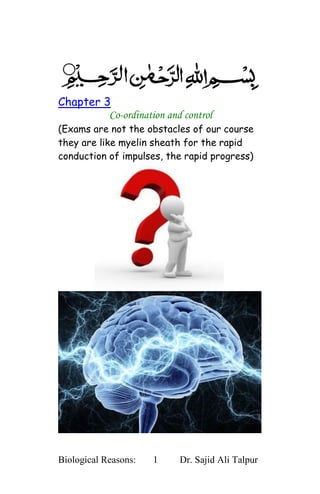
Coordination and Control Chapter 3
- 1. Chapter 3 Co-ordination and control (Exams are not the obstacles of our course they are like myelin sheath for the rapid conduction of impulses, the rapid progress) Biological Reasons: 1 Dr. Sajid Ali Talpur
- 2. Q 1: Do plants feel pain? Ans. No, because they do not have nervous system. Q 2: Which phytohormone is known as growth promoter and why? Ans. Most of the hormones act as growth promoter but Gibberelin serves for the purposes by winding up dwarfism. Q 3: Why certain plants get delayed age and live long? Ans. It happens so because of the high quantity of cytokinins and low quantity of abscisic acid.. since cytokinin promotes the production of chlorophyll. Q 4: Why the emerge of abscission layer causes fall of the fruit? Ans. Because it serves as the separating agent between the fruit and stalk, also it breaks or weakens the other connecting cells. Q5: Why certain plants undergo parthenocarpy? Ans. Certain plants undergo production of fruits without fertilization, known as parthenocarpy which is caused by several factors but mostly due to high concentration of auxins. Q6: How ethen works as fruit ripening agent? Ans: It affects permeability of cell membrane which activates the enzymes to destroy chloroplast subsequently red and yellow colors appear and the fruit assumes the ripened color. Biological Reasons: 2 Dr. Sajid Ali Talpur
- 3. Q 7: How plants response to herbivory? Ans. they overcome herbivory by developing thorns and producing distasteful or toxic compounds. Q 8: How plants response to heat stress? Ans. They overcome over heating by transpiration as a cooling effect and by producing heat shock proteins when temperature is above 40oC, which prevent enzymes and other metabolic proteins from getting denatured. Q 9: What is the role of hormones in drought conditions? Ans. Abscisic acid is release from mesophyll cells in leaf, which keeps stomata close and supports water conservation by reducing transpiration. Q10. Why biorhythms are called endogenous? Ans. Because they do not depend upon external factors like light and temperature but on internal system. Q11: Which of the three types of neurons is slow impulse conducting and why? Ans. Inter neuron because it is unmylinated. Since it is in CNS and covers a small distance so the slow conduction is sufficient. Q12. How do you differentiate between sensation and perception? Ans. The awareness of stimulus is called sensation and the recognition of the stimulus is called perception. Biological Reasons: 3 Dr. Sajid Ali Talpur
- 4. Q13: What is the effect on nervous system of not taking salt at all? Ans. there will be nerve impulse and conduction problems. Because Na (mainly obtained from salt) along with potassium maintains RMP, also the entry of Na ions into the neuron is the primary requirement of action potential. Q14: Why synapse requires neurotransmitters for the transmission of impulse? Ans. because there is a gap between the two neurons and the impulse can not be transmitted directly. Therefore neurotransmitters carry signals from one presynaptic membrane through synaptic cleft to the postsynaptic membrane and cause depolarization in it. In this way the nerve impulse is transmitted from one neuron to another neuron with the help of neurotransmitters. Q15: What is the significance of reflex action? Ans. Reflex Actions are automatic, involuntary responses due to either internal or external stimuli, which protect us from deep damages like hand withdrawal on a painful stimulus, blinking of eyes protecting entry of insects etc. Q16: Can a chick consider duck his mother instead of hen? Ans. Yes, provided, the chick finds duck as its mother when it hatches and it will follow the duck as its mother no matter its real mother i.e. hen is present. This is called imprinting. Biological Reasons: 4 Dr. Sajid Ali Talpur
- 5. Q17: What do you think learned behavior is more common in humans or other animals? Ans. In humans. Because they are born totally ignorant while the animals are highly educated about their requirements by birth. Q18: Lion is not as aggressive in zoo as in jungle. How do you explain this statement? Ans. This is a learned behavior called habituation in which the lion has adapted to remain calm in the zoo. Biological Reasons: 5 Dr. Sajid Ali Talpur
